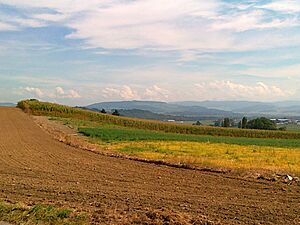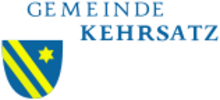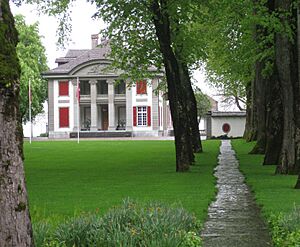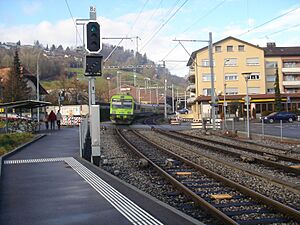Kehrsatz facts for kids
Quick facts for kids
Kehrsatz
|
||
|---|---|---|
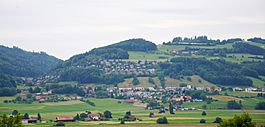
Kehrsatz village
|
||
|
||
| Country | Switzerland | |
| Canton | Bern | |
| District | Bern-Mittelland | |
| Area | ||
| • Total | 4.44 km2 (1.71 sq mi) | |
| Elevation | 570 m (1,870 ft) | |
| Population
(Dec 2020 )
|
||
| • Total | 4,380 | |
| • Density | 986.5/km2 (2,555/sq mi) | |
| Postal code |
3122
|
|
| Surrounded by | Belp, Köniz, Muri bei Bern, Wald | |
Kehrsatz is a town, also called a municipality, in the Bern-Mittelland area of Bern canton in Switzerland. It's a place where people live and work, just like a small city or a large village.
Contents
History of Kehrsatz
Kehrsatz was first written about in the year 1281. Back then, it was called Kersaz.
Long ago, people lived here even before Kehrsatz was named. We know this because some ancient La Tène graves were found. These graves are from a very old European culture. During the Roman times, there was a busy village with Gallo-Roman farmhouses. A collection of Roman coins was also found nearby.
In the Middle Ages, Kehrsatz was part of a larger territory called a Herrschaft. This meant it was ruled by a powerful family or lord. Over time, the city of Bern slowly gained more control. By the 1400s, Bern had the right to run the local courts, called the "low court right". Later, they also gained "Zwing or Twing" rights, which gave them even more power over the people and land.
In 1388, Kehrsatz became part of Bern's Seftigen district. Kehrsatz Castle was built in the 1300s for the local ruler. It was rebuilt in the 1500s and fixed up many times since then. For centuries, rich families from Bern, known as patricians, governed Kehrsatz.
Things changed a lot after the French invasion in 1798. Switzerland became the Helvetic Republic. Kehrsatz then became its own independent municipality. The canton of Bern bought the castle. In 1888, it became a boarding school for girls. Today, it is still a school run by the canton.
In the late 1800s and early 1900s, new roads and a railway line connected Kehrsatz to Bern. This made it easier for people to travel. In the 1960s, Bern grew very fast. Kehrsatz became a suburb and part of Bern's larger city area. In 1969, a new school opened in Selhofen for all the new children.
Geography of Kehrsatz
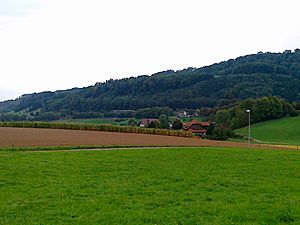
Kehrsatz covers an area of about 4.4 square kilometers (1.7 square miles). A big part of this land, about 54.5%, is used for farming. Forests cover about 22.3% of the area. The rest of the land, about 21.2%, has buildings or roads on it. A small part, 1.4%, is rivers or lakes.
Most of the forested land, 20.7%, is covered with thick trees. About 1.6% has orchards or small groups of trees. For farming, 33.1% of the land grows crops. Another 18.9% is used for pastures where animals graze.
The municipality is located on a flat area, like a terrace. This terrace is on the south-east side of the Gurten mountain.
On December 31, 2009, the old district of Seftigen was closed. The next day, Kehrsatz joined the new Bern-Mittelland administrative district.
Kehrsatz Coat of Arms
The blazon (description) of Kehrsatz's coat of arms is: A blue shield with two yellow diagonal stripes. There is also a yellow star in the top left corner.
People of Kehrsatz (Demographics)
Kehrsatz has a population of about 4,120 people (as of December 2012). About 19% of the people living here are from other countries. In recent years, the population has grown a little bit.
Most people in Kehrsatz, about 86.9%, speak German as their main language. French is spoken by about 2.0% of the people. Italian is spoken by about 1.9%.
In 2008, about 48.9% of the population were boys and men. About 51.1% were girls and women. Most of the people living in Kehrsatz were born in Switzerland. About 17.8% were born right in Kehrsatz.
In 2012, children and teenagers (ages 0-19) made up 21.8% of the population. Adults (ages 20-64) made up 57.9%. Older people (over 64) made up 20.3%.
Many people in Kehrsatz are married. In 2000, about 1,901 people were married. There were also many single people, about 1,487.
Most homes in Kehrsatz are lived in all the time. In 2010, there were 514 homes where only one person lived. There were 119 homes with five or more people.
The chart below shows how the population of Kehrsatz has changed over many years:

Important Historical Sites
The country estate called Landsitz Lohn is a very important historical place. It is listed as a heritage site of national significance in Switzerland. This means it's a special place that needs to be protected.
Economy of Kehrsatz
In 2011, the unemployment rate in Kehrsatz was low, at 2.31%. This means most people who wanted jobs had them.
Kehrsatz has different types of jobs. In 2011, about 59 people worked in the primary sector. This means they worked in farming or getting raw materials. About 200 people worked in the secondary sector, which includes making things or building. The largest group, 689 people, worked in the tertiary sector. This includes jobs like selling things, teaching, or working in healthcare.
Many people who live in Kehrsatz travel to other towns for work. In 2000, about 1,607 people left Kehrsatz to work elsewhere. About 675 people came into Kehrsatz to work. This shows that more people leave Kehrsatz for jobs than come in.
Many people use public transportation, like trains or buses, to get to work. About 34.5% of workers used public transport. About 44.8% used a private car.
Religion in Kehrsatz
Based on a survey from 2000, most people in Kehrsatz belong to a Christian church. About 60.7% were part of the Swiss Reformed Church. Another 16.8% were Roman Catholic.
There were also smaller groups of other religions. About 2.10% were Orthodox Christians. About 2.96% belonged to other Christian churches. There were also people who were Muslim (4.29%), Hindu (45 people), and Buddhist (5 people).
Some people, about 7.95%, said they did not belong to any church.
Education in Kehrsatz
In Kehrsatz, many adults have a good education. About 52.7% of people have finished high school or similar education. About 25.8% have gone on to higher education, like university.
The schools in Bern canton, where Kehrsatz is, have a special system. Children usually go to kindergarten for one year. Then they go to primary school for six years. After that, they have three years of lower secondary school. In secondary school, students are grouped by how well they learn. After secondary school, students can go to more schools or start an apprenticeship to learn a job.
In the 2011-2012 school year, about 503 students went to school in Kehrsatz. There were 77 children in kindergarten. About 249 students were in primary school. And 166 students were in lower secondary school. Some students in Kehrsatz schools were from other countries or spoke a different language at home.
Kehrsatz also has a local library called Dorfbibliothek Kehrsatz. In 2008, the library had over 5,200 books and other things to borrow. It lent out over 6,100 items that year. The library was open 127 days a year, for about 6 hours each week.
|
See also
 In Spanish: Kehrsatz para niños
In Spanish: Kehrsatz para niños







